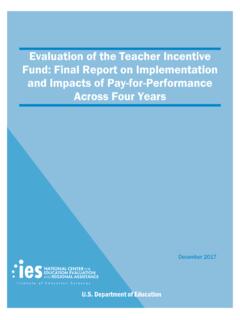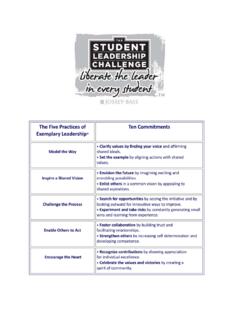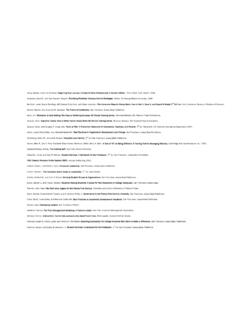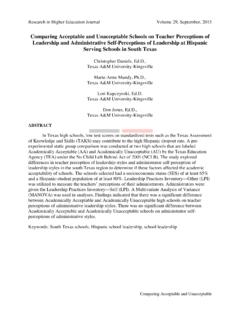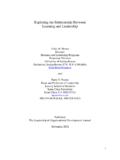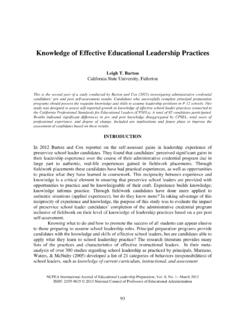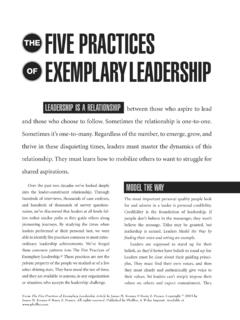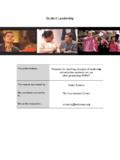Transcription of Measuring student engagement in upper elementary through ...
1 ISSUES&ANSWERSREL 2011 No. 098At SERVE Center UNC, GreensboroMeasuring student engagement in upper elementary through high school: a description of 21 ins trument sISSUES&ANSWERSREL 2011 No. 098At SERVE Center UNC, GreensboroMeasuring student engagement in upper elementary through high school: a description of 21 instrumentsJanuary 2011 Prepared byJennifer Fredricks, Connecticut CollegeWendy McColskey, SERVE Center at the University of North Carolina at GreensboroJane Meli, , Bianca Montrosse, , SERVE Center at the University of SERVE Center at the University of North Carolina at GreensboroNorth Carolina at GreensboroJoy Mordica, , Kathleen Mooney.
2 SERVE Center at the University of SERVE Center at the University of North Carolina at GreensboroNorth Carolina at GreensboroWAORIDMTNVCAUTAZWYNDSDNEKSCONM TXOKCOARLAMSALGASCNCVAWVKYTNPANYFLAKMNWI IAILINMIOHVTNHMEMOAt SERVE Center UNC, GreensboroIssues & Answers is an ongoing series of reports from short-term Fast Response Projects conducted by the regional educa-tional laboratories on current education issues of importance at local, state, and regional levels. Fast Response Project topics change to reflect new issues, as identified through lab outreach and requests for assistance from policymakers and educa-tors at state and local levels and from communities, businesses, parents, families, and youth.
3 All Issues & Answers reports meet Institute of Education Sciences standards for scientifically valid research. Ja nua r y 2011 This report was prepared for the Institute of Education Sciences (IES) under Contract ED-06-CO-0028 by Regional Educa-tional Laboratory Southeast administered by SERVE Center at the University of North Carolina at Greensboro. The content of the publication does not necessarily reflect the views or policies of IES or the Department of Education nor does mention of trade names, commercial products, or organizations imply endorsement by the report is in the public domain.
4 While permission to reprint this publication is not necessary, it should be cited as: Fredricks, J., McColskey, W., Meli, J., Mordica, J., Montrosse, B., and Mooney, K. (2011). Measuring student engagement in upper elementary through high school: a description of 21 instruments. (Issues & Answers Report, REL 2011 No. 098). Wash-ington, DC: Department of Education, Institute of Education Sciences, National Center for Education Evaluation and Regional Assistance, Regional Educational Laboratory Southeast. Retrieved from report is available on the regional educational laboratory website at student engagement in upper elementary through high school: a description of 21 instrumentsREL 2011 No.
5 098 This report reviews the characteristics of 21 instruments that measure stu-dent engagement in upper elementary through high school. It summarizes what each instrument measures, describes its purposes and uses, and provides tech-nical information on its psychometric , educators, and policymakers are increasingly focused on student engage-ment as the key to addressing problems of low achievement, student boredom and alienation, and high dropout rates (Fred-ricks, Blumenfeld, and Paris 2004). To increase student engagement , educators and evaluators need to understand how engage-ment has been defined and to assess the op-tions for Measuring it.
6 However, instruments for Measuring engagement are not easily accessible as a group in a way that allows for comparison because they arise from differ-ent disciplinary perspectives and theoretical report summarizes the characteristics of instruments that measure student engagement in upper elementary through high school, providing information on the range of instru-ments available. It is not a technical review of the quality of these findings are organized in response to two questions addressed by the study: What instruments are available to mea-sure student engagement in upper elemen-tary through high school?
7 What are the characteristics of each iden-tified measure?The report describes the results of a litera-ture review to identify available instruments. The 21 instruments identified are described according to what is measured, their pur-pose and use, and the technical information available on their psychometric properties. The instruments include 14 student self-report instruments, 3 teacher reports on students , and 4 observational measures What is measured. The constructs assessed can be described by the extent to which the instruments represent the multidi-mensional nature of engagement (behav-ioral, emotional, and cognitive) and the object of engagement .
8 Of the 14 student self-report instruments described, 5 as-sess all three dimensions of engagement , 5 assess two dimensions, and 4 assess one dimension. Nine are worded to reflect general engagement in school, and five are ii Summaryworded for use at the class level. Two of the three teacher report instruments can be used by teachers for reporting on student engagement in any subject and the third for reporting on engagement in reading. Two of the four observation measures provide a coding system for observing an individual student s on- and off-task behavior or engaged time in classroom settings, and two assess classroom engage-ment across all students in the class.
9 Purpose and use. The 21 instruments have several different purposes and uses, including research on motivational and cognitive theories of learning; research on disengagement and dropping out; evaluation of school reform efforts and interventions; monitoring of engagement at the teacher, school, or district level; diagnosis and monitoring at the student level; and needs assessment of students developmental assets (the relationships, opportunities, and personal qualities that young people need to avoid risks and enhance positive outcomes). Technical information on psychomet-ric properties.
10 Reliability and validity information was found for all but one instrument. Overall, developers reported internal consistency results for student self-report and teacher report measures that were at or near acceptable levels for use, ranging from .49 to .93, with most scales at .70 to .80. Substantial information was also available on validity. For exam-ple, 13 measures had positive correlations with measures of student achievement. This report does not judge whether the technical information accessed is sufficient for any particular use of an 2011 Table of conTenTS iiiTable of conTenTsAbbreviations vWhy this study?





